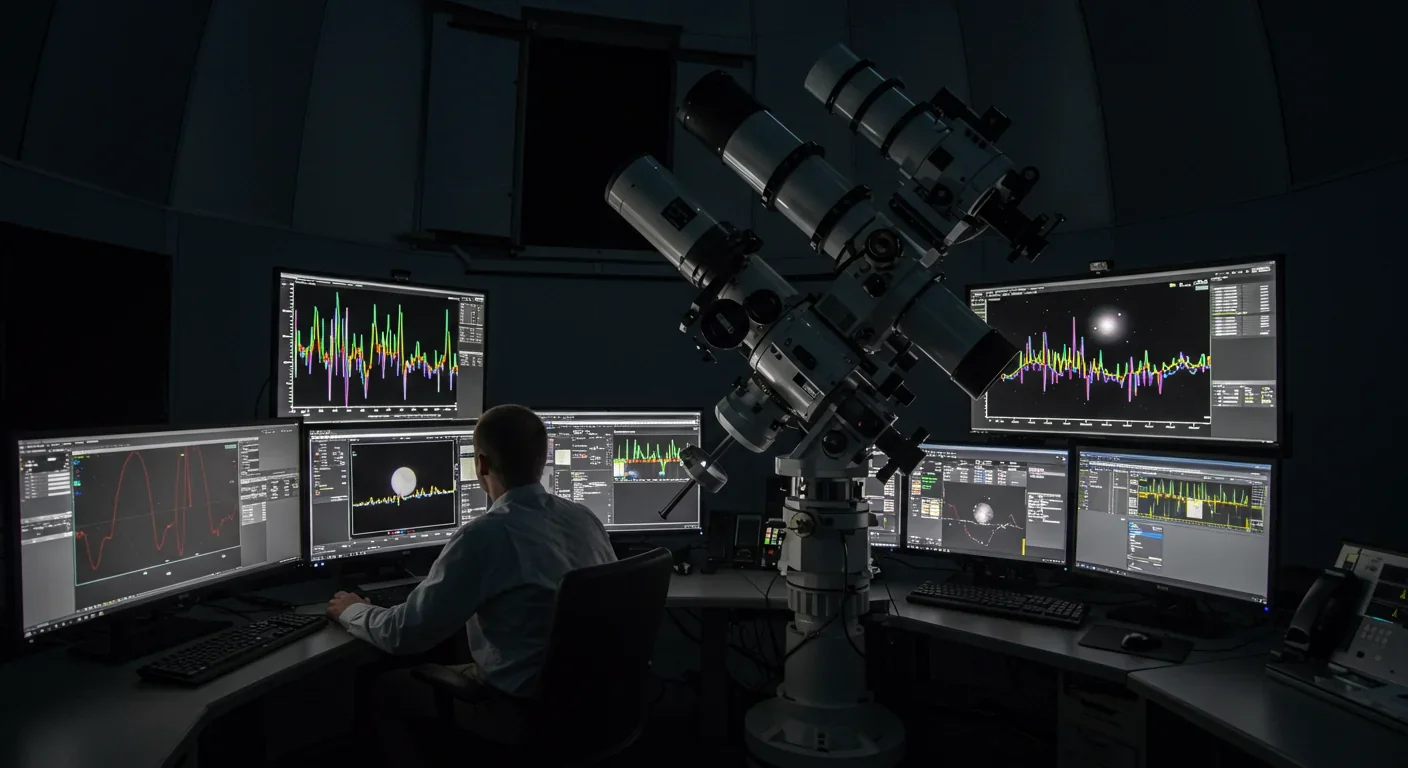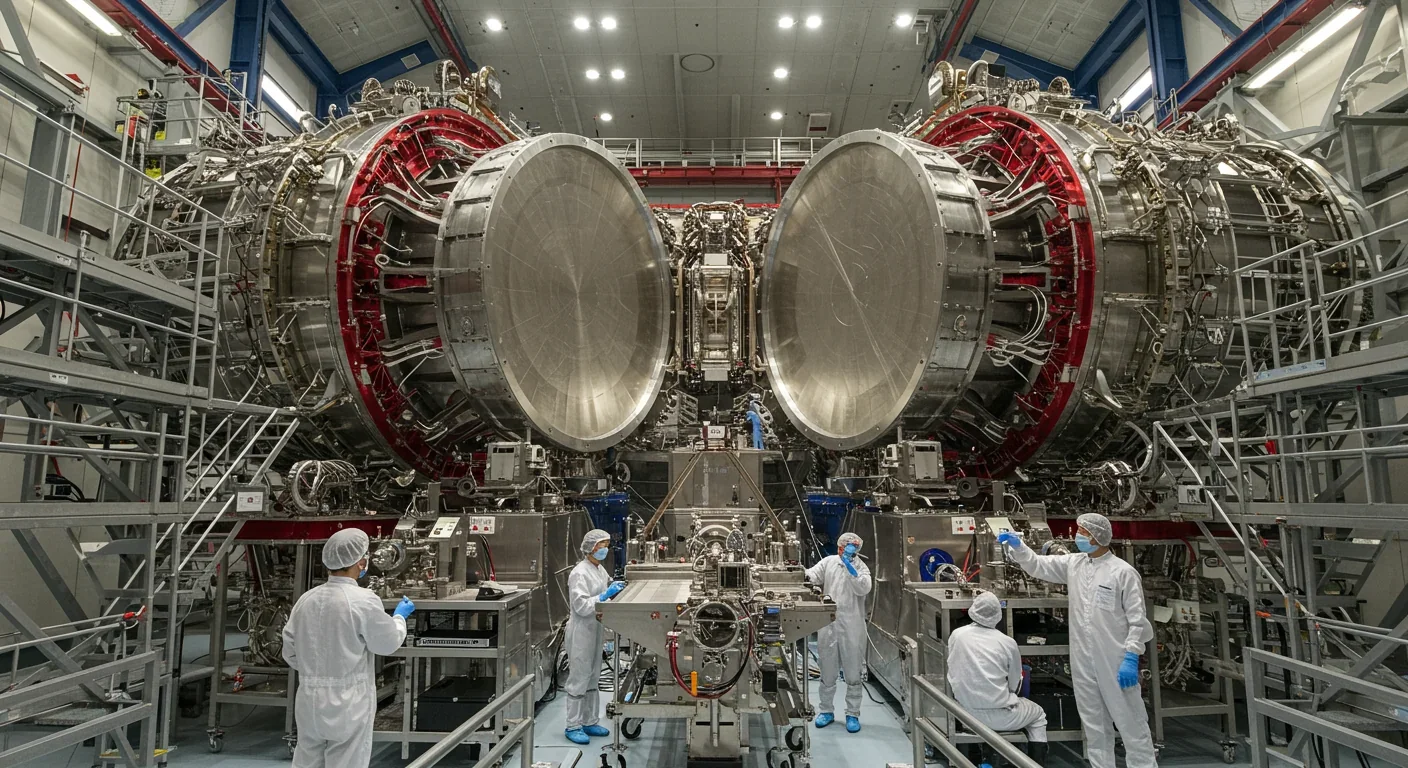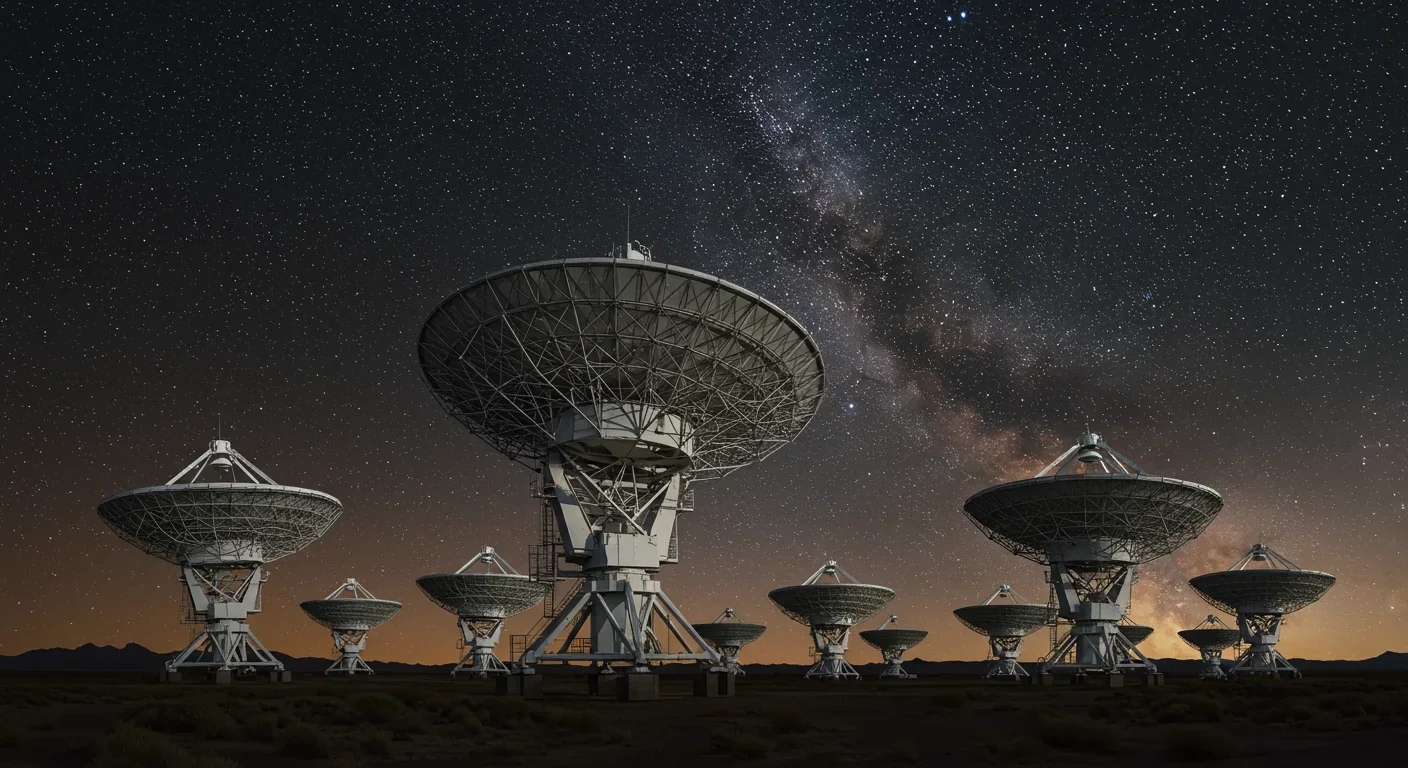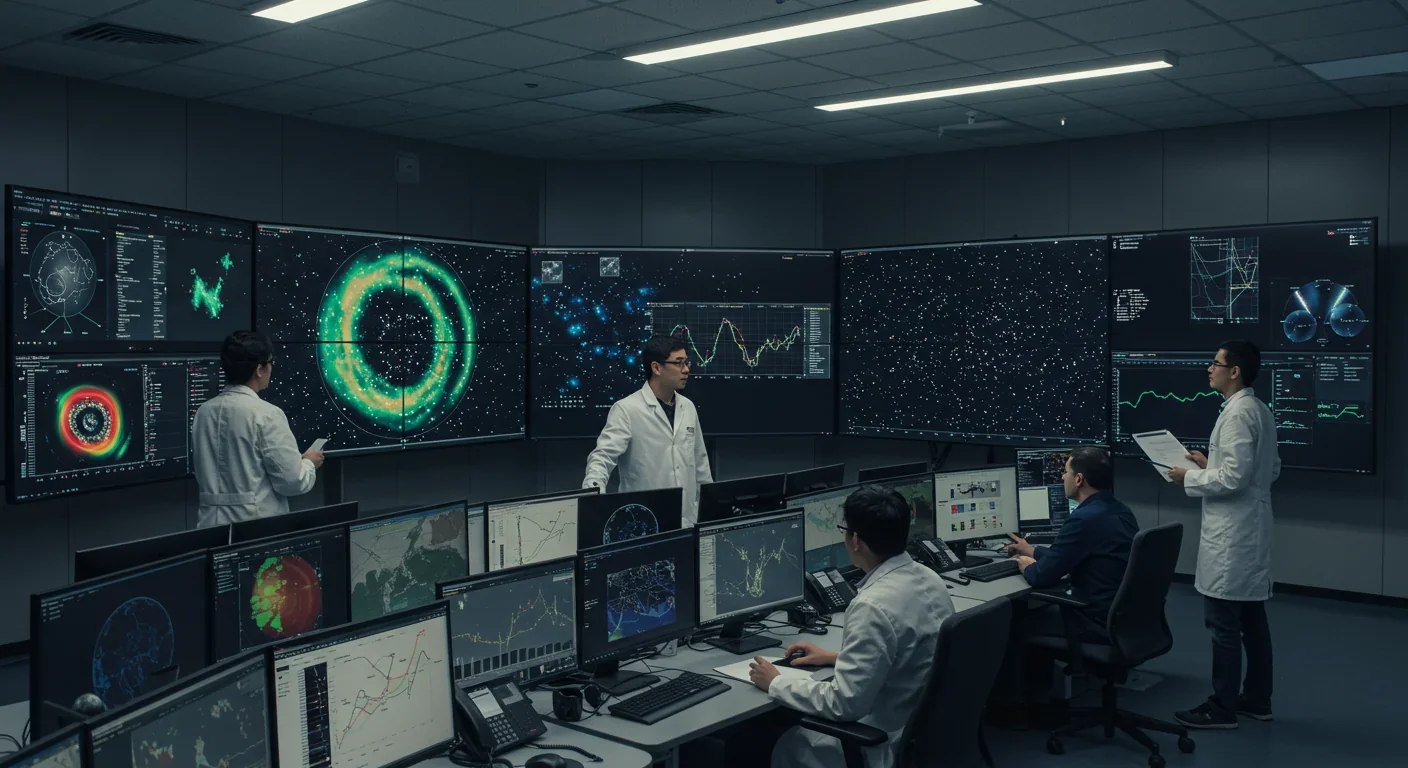White Dwarf Spectroscopy Reveals Destroyed Exoplanets

TL;DR: Cosmic strings—hypothetical one-dimensional defects from the Big Bang—may soon be detected or ruled out by gravitational wave observatories, CMB surveys, and galaxy mapping. These ultra-dense threads could validate grand unified theories, constrain inflation models, and even provide evidence for string theory. Within a decade, missions like LISA, CMB-S4, and pulsar timing arrays will deliver a verdict, reshaping our understanding of the universe's earliest moments and fundamental physics.

Imagine a flaw in the fabric of spacetime itself—a thread left behind when the universe cooled after the Big Bang, thinner than a proton but heavier than a mountain. Cosmic strings, if they exist, are exactly that: one-dimensional defects in reality that could reshape our understanding of physics, structure formation, and the very nature of the cosmos. For decades these hypothetical ribbons have remained in the realm of theory, but today a new generation of gravitational wave observatories, cosmic microwave background surveys, and galaxy-mapping projects is closing in on them with unprecedented precision. Within the next decade, you'll likely hear whether these exotic relics are real—or whether decades of theoretical work must be rewritten.
For forty years cosmic strings were a beautiful idea with no experimental test. That changed in September 2015 when LIGO detected gravitational waves from merging black holes, inaugurating an era of gravitational wave astronomy. By 2023 pulsar timing arrays—galaxy-scale detectors that monitor millisecond pulsars across the Milky Way—announced they had measured a faint hum of nanohertz gravitational waves pervading the universe. While most astrophysicists attribute this background to supermassive black hole binaries, the data leave room for an alternative: oscillating loops of cosmic string radiating gravitational energy across billions of years.
Simultaneously, analyses of the Planck satellite's all-sky map of the cosmic microwave background (CMB) have ruled out cosmic strings as the dominant seed of galaxy formation, yet they set an upper limit on string tension—essentially the mass per unit length—that is still orders of magnitude above the detection threshold of next-generation instruments. LIGO's third observing run in 2021 tightened the noose further, constraining the tension parameter Gμ to below 4 × 10⁻¹⁵ for certain theoretical models. In parallel, theorists have shown that if cosmic strings formed during the inflationary epoch, the number of expansion e-folds they survived correlates directly with features in the CMB power spectrum and the amplitude of the stochastic gravitational wave background. This multi-messenger convergence means that within five to ten years, missions like LISA (the Laser Interferometer Space Antenna), CMB-S4, and the Square Kilometre Array could either confirm cosmic strings or rule out vast swaths of grand unified theory parameter space.
The implications are profound. Detection would validate a cornerstone prediction of high-energy physics and open a direct observational window to energy scales a trillion times beyond the reach of any particle collider. Non-detection would force theorists to abandon or radically revise models of symmetry breaking, inflation, and even string theory itself. Either way, the hunt for cosmic strings is about to deliver a verdict on one of the universe's deepest mysteries.
To understand cosmic strings, look to history—not cosmic history, but the history of phase transitions. When water freezes into ice, crystals grow from multiple nucleation points and meet along irregular boundaries, creating cracks and defects. In 1976 physicist Tom Kibble proposed that the early universe underwent analogous phase transitions as it cooled, breaking fundamental symmetries and leaving behind topological defects: domain walls (two-dimensional sheets), cosmic strings (one-dimensional lines), and magnetic monopoles (zero-dimensional points).
Just as the printing press disrupted medieval information monopolies by freezing ideas into reproducible form, cosmic strings froze the universe's primordial symmetries into tangible, observable structures. The mathematics is elegant: whenever a field theory undergoes spontaneous symmetry breaking and the resulting vacuum manifold has a nontrivial first homotopy group, line defects—cosmic strings—must form. This is not exotic speculation; it is a generic prediction of gauge theories that unify the electromagnetic, weak, and strong forces at high energy. In a sense, cosmic strings are the universe's scar tissue, marking where different regions of space chose different vacuum states and could not reconcile.
Historically, theorists hoped these defects might seed galaxy formation. In the 1980s Yakov Zeldovich envisioned cosmic strings as the "seeds of a cosmic garden," with their immense gravitational pull attracting matter into filaments and clusters. By the late 1990s, however, precision CMB measurements from COBE and later WMAP revealed that the primordial density perturbations were overwhelmingly adiabatic—smooth compressions and rarefactions—rather than the isocurvature (entropy) perturbations that strings would produce. Cosmic strings could contribute at most 10 % of the CMB anisotropy, effectively ending their candidacy as the primary architects of large-scale structure. Yet that 10 % window, combined with new gravitational wave and lensing probes, keeps them alive as a subdominant but potentially detectable phenomenon.

Modern cosmic string searches exploit three complementary channels: gravitational waves, the cosmic microwave background, and large-scale structure surveys.
Gravitational Waves: Cosmic strings are not static. They writhe and oscillate, shedding loops that decay by radiating gravitational waves. Key emission features include cusps (points where the string momentarily moves at light speed), kinks (sharp bends formed when strings intersect), and kink-kink collisions. Each produces a characteristic burst or, collectively, a stochastic background spanning frequencies from nanohertz (pulsar timing arrays) through millihertz (LISA) to hundreds of hertz (LIGO/Virgo/KAGRA). The O3 observing run analyzed data for all three signal types and, finding none, set the tightest limits yet: for a one-loop distribution model, string tension must be Gμ < 4 × 10⁻¹⁵. Because gravitational waves interact negligibly with matter, they carry information from epochs and regions invisible to light, making them the ultimate cosmic archaeology tool.
Cosmic Microwave Background: A moving cosmic string drags spacetime into a wedge with a deficit angle proportional to its tension. Photons traversing this wedge experience the Kaiser-Stebbins effect—a step discontinuity in temperature across the string's path. Planck's all-sky survey looked for such discontinuities and found none above the 10 % contribution level, yielding an upper limit Gμ ≲ 10⁻⁷. Next-generation experiments like CMB-S4 will push sensitivity down by another order of magnitude, hunting not only temperature steps but also distinctive patterns in polarization (B-modes) induced by gravitational lensing from string networks.
Large-Scale Structure: A straight cosmic string passing in front of a distant galaxy acts as a gravitational lens, producing two identical, undistorted images—an unmistakable signature. Surveys like the Sloan Digital Sky Survey and upcoming projects with the Vera Rubin Observatory scan billions of galaxies for such paired images. Moreover, a moving string leaves a wake—a planar overdensity of matter—where shocked intergalactic gas can amplify magnetic fields via the Biermann battery mechanism. Charged particles crossing these magnetized wakes emit synchrotron radiation across radio frequencies, creating a broad emission peak detectable by the Square Kilometre Array and LOFAR. Recent simulations show peak magnetic fields in wakes can quintuple over cosmological timescales, though reconnection at small scales (set by the particle gyroradius) can cause decay, limiting observability.
Together these probes form a detection web. A single channel's null result constrains string tension; correlated signals across channels would constitute ironclad evidence.
The societal impact of discovering—or definitively excluding—cosmic strings will reverberate far beyond physics departments. Consider the historical parallel: when Galileo turned his telescope skyward and found moons orbiting Jupiter, he shattered the Aristotelian cosmos and set in motion the Scientific Revolution, reshaping politics, religion, and philosophy. Cosmic strings, if found, would be the 21st century's Galilean moons.
Industries Affected: Gravitational wave astronomy is already a growth sector, with billions invested in LIGO upgrades, LISA's 2035 launch, and the proposed Einstein Telescope in Europe. Confirmation of cosmic strings would turbocharge funding and attract talent, much as the Higgs boson discovery validated decades of collider physics investment. Data science and machine learning will be central—sifting petabytes of detector noise for rare string signals demands algorithms that could spin off into finance, cybersecurity, and medical imaging. Conversely, if strings are ruled out, theorists will pivot toward alternative probes of quantum gravity (e.g., primordial black holes, axion dark matter), redirecting research priorities and grant allocations.
Job Market Implications: A cosmic string detection would create demand for specialists in gravitational wave data analysis, high-energy cosmology, and topological field theory—fields currently niche but poised for expansion. Universities in Chile (home to the Atacama Desert's CMB observatories), Louisiana and Washington (LIGO sites), and Europe (Virgo, Einstein Telescope) would become hubs. Conversely, the interdisciplinary skills—statistical inference, signal processing, large-scale simulation—are portable, ensuring that even if strings remain hypothetical, the workforce trained to hunt them will drive innovation elsewhere.
Cultural Shifts Expected: Science communication will face a challenge: cosmic strings sound like science fiction. Yet their story—cracks in spacetime, galaxy-scale antennas, echoes from the Big Bang—is inherently compelling. Successful public engagement (think Brian Cox's documentaries or Neil deGrasse Tyson's podcasts) could inspire a generation to pursue STEM, much as the Apollo program did. Philosophically, cosmic strings personify the idea that the universe's present structure encodes its past: just as geologists read Earth's history in rock strata, cosmologists read the universe's phase transitions in its defects. This narrative reinforces the scientific worldview—that nature's laws are decipherable and that human ingenuity can reconstruct events a trillionth of a second after creation.
Why does a thread of spacetime matter? Because cosmic strings are fossil evidence of physics at energies around 10¹⁶ GeV—the grand unification scale, where electromagnetism, weak, and strong forces merge. Particle colliders like the LHC reach only 10⁴ GeV; cosmic strings offer a natural accelerator a trillion times more powerful. Detecting them would confirm that the Standard Model is embedded in a larger, unified framework, a dream pursued since the 1970s.
Constraining Inflation: If strings formed before or during inflation, their gravitational wave spectrum encodes the number of inflationary e-folds and the spectral index n_s—parameters measured independently by Planck. A match would validate specific inflationary models (e.g., α-attractor inflation) and rule out rivals, narrowing the field from dozens to a handful. This cross-check between CMB photons and gravitational wave phonons exemplifies multi-messenger cosmology's power.
Testing String Theory: Ironically, cosmic strings (field-theory defects) differ from superstrings (fundamental one-dimensional objects in string theory). Yet string theory predicts cosmic superstrings—wrapped branes from the compactification of extra dimensions—with tensions potentially detectable by pulsar timing arrays. NANOGrav's 2023 stochastic background hints (but does not confirm) such a signal. If verified and attributed to superstrings rather than black hole binaries, it would be the first observational evidence for string theory and extra dimensions, the holy grail of theoretical physics.
Probing Dark Matter and Energy: Some models propose that cosmic strings contribute to dark energy, effectively mimicking a cosmological constant. Recent Bayesian analyses of Planck, DESI, and supernova data find a slight statistical preference (Δχ² = –6.07) for negative-tension string networks, though conventional ΛCDM remains favored. If future data strengthen this preference, cosmic strings could partially explain the universe's accelerated expansion, reducing reliance on the mysterious dark energy.
Seeding Structure: Even at the 10 % level, cosmic strings could have nucleated the first galaxies, influencing where stars ignited and life emerged. Simulations show string wakes could drive matter into filaments, explaining the cosmic web's topology. Understanding this would complete the story of structure formation from quantum fluctuations to galaxies.

The hunt for cosmic strings faces formidable obstacles—technical, theoretical, and interpretive.
Technical Limits: Gravitational wave detectors operate at the edge of measurability. LIGO's mirrors detect displacements a thousandth the width of a proton; any vibration—earthquakes, traffic, quantum shot noise—can mimic or mask a signal. Advanced LIGO improved sensitivity tenfold, yet cosmic string bursts remain below the noise floor for most parameter space. LISA, launching in the 2030s, will probe lower frequencies but must contend with laser phase noise over million-kilometer arms. Pulsar timing arrays face their own demons: intrinsic pulsar timing irregularities (red noise) can masquerade as gravitational waves, requiring sophisticated Bayesian statistical models to disentangle. The NANOGrav collaboration's 15-year dataset just crossed the threshold; definitive conclusions demand another decade.
Theoretical Uncertainties: Predicting string signals requires knowing how many loops form, how long they survive, and how many kinks they carry—all outputs of field-theory simulations that are computationally expensive and model-dependent. Recent Abelian-Higgs simulations suggest only a tiny fraction of loops survive to radiate, loosening constraints by orders of magnitude. Moreover, cosmic strings from grand unification differ from those in string theory, from phase transitions in axion fields, or from frustrated domain wall networks. Each scenario predicts different tensions and spectra, fragmenting the search.
Degeneracy with Astrophysics: The stochastic gravitational wave background detected by pulsar timing arrays is most naturally explained by supermassive black hole binaries in merging galaxies. Disentangling a subdominant cosmic string component requires exquisite frequency resolution and multiple collaborations (NANOGrav, EPTA, PPTA, InPTA, CPTA) cross-checking. The current Bayes factors favor black holes over pure string models, but hybrid models remain viable.
Ethical and Equity Concerns: Gravitational wave and CMB observatories are expensive, sited in geopolitically privileged locations (U.S., Europe, Chile, Antarctica), and require decades of stable funding—resources unavailable to most nations. While the science is universal, the capacity to participate is not. Ensuring that data, software, and training are open-access can democratize the field, but disparities in infrastructure will persist. Additionally, the all-consuming pursuit of cosmic strings risks overshadowing equally important, less glamorous research—e.g., systematic studies of neutron star equations of state or galactic foreground contamination in CMB maps.
Unintended Consequences: If cosmic strings are detected, the ensuing hype could distort priorities, funneling resources away from other frontiers (dark matter direct detection, neutrino astronomy). If they are excluded, a generation of theorists will have spent careers on a blind alley—though the methods and technologies developed (Bayesian inference, cryogenic sensors, precision timing) will endure.
Cosmic string science is inherently international. The LIGO-Virgo-KAGRA network spans the U.S., Italy, and Japan. Pulsar timing arrays coordinate across continents. CMB observatories in Chile's Atacama Desert, Antarctica's South Pole, and space (Planck, proposed LiteBIRD) pool data. This collaboration is both strategic and cultural.
United States: Home to LIGO's two sites and a leader in gravitational wave theory, the U.S. invests heavily in the field—over $1 billion for LIGO upgrades and operations. Yet budget uncertainty (government shutdowns, shifting NASA priorities) threatens long-term projects like LISA.
Europe: The Virgo interferometer in Italy and the proposed Einstein Telescope (a subterranean, cryogenic detector ten times more sensitive than LIGO) position Europe as a gravitational wave powerhouse. The European Space Agency co-leads LISA with NASA. European theorists, particularly in the U.K. and Germany, pioneered cosmic string models in the 1980s and remain at the forefront.
China: The Chinese Pulsar Timing Array (CPTA) and the proposed TianQin space-based detector signal China's ambition to lead in gravitational wave science. TianQin would complement LISA, offering redundancy and independent verification—critical for rare signals like cosmic strings.
India and Australia: The proposed LIGO-India and existing Parkes telescope (part of PPTA) extend the detector network, improving sky localization and uptime. India's participation also builds domestic expertise and inspires its vast student population.
Culturally, the search for cosmic strings embodies different values. Western science emphasizes individual breakthroughs and Nobel-worthy discoveries; East Asian models stress long-term collective projects and incremental progress. Both are necessary: cosmic string detection will require patience, coordination, and the occasional flash of insight.
Tensions exist. Data-sharing agreements, authorship on 3,000-author papers, and credit allocation strain collaboration. Geopolitical friction—U.S.-China tech competition, Brexit's impact on European funding—can impede joint projects. Yet the universality of gravitational waves and the scale required to detect them make isolationism impractical. Cosmic strings, if they exist, belong to no nation.
Whether you are a student, educator, or curious citizen, the cosmic string hunt offers lessons and opportunities.
Skills to Develop:
Data Science and Statistics: Bayesian inference, machine learning for anomaly detection, and signal processing are central. Online courses (Coursera, edX) and open-source tools (PyTorch, TensorFlow, ENTERPRISE for pulsar timing) are accessible.
Programming: Python dominates astrophysics; familiarity with NumPy, SciPy, Matplotlib, and Jupyter notebooks is essential. High-performance computing (MPI, GPU acceleration) is a plus.
Physics Fundamentals: General relativity, quantum field theory, and statistical mechanics underpin cosmic string theory. Textbooks like Carroll's Spacetime and Geometry and Peskin & Schroeder's Quantum Field Theory are standards.
Interdisciplinary Thinking: Cosmic strings bridge particle physics, cosmology, and astronomy. Cultivate the ability to translate between fields and synthesize disparate data.
How to Adapt:
Follow the Data: Public releases from LIGO (GWOSC), Planck (ESA archives), and NANOGrav (GitHub repositories) let anyone explore real gravitational wave and CMB data. Citizen science projects like Einstein@Home harness volunteer computing power to search for signals.
Engage with the Community: Conferences (APS, AAS, COSPAR), preprint servers (arXiv), and social media (#GravitationalWaves, #Cosmology) keep you current. Many talks are livestreamed.
Teach and Communicate: The complexity of cosmic strings demands clear explanation. Blogs, YouTube channels, and public lectures build your own understanding while inspiring others.
Stay Skeptical and Curious: Science progresses through falsification. Cosmic strings may not exist—but the quest to find them will yield serendipitous discoveries, from new pulsars to unexpected gravitational wave sources.
For policymakers and funders, the message is clear: sustained investment in fundamental research pays dividends. LIGO's development spanned forty years and half a billion dollars before detecting its first wave; the economic and technological spinoffs (laser stabilization, seismic isolation, data algorithms) exceed the cost. Cosmic strings are a long bet, but the tools built to find them—gravitational wave observatories, supercomputers, international collaborations—are infrastructure for the future.
Within a decade, the convergence of gravitational wave detectors, CMB satellites, and galaxy surveys will deliver a verdict on cosmic strings. LISA's launch in the mid-2030s, CMB-S4's first light in the late 2020s, and continued pulsar timing array observations will probe parameter space orders of magnitude beyond today's limits. If cosmic strings exist with tensions in the Gμ ~ 10⁻¹² to 10⁻⁷ range, we will see them. If not, vast swaths of grand unified theory will be ruled out, forcing a rethink of symmetry breaking, inflation, and the thermal history of the universe.
Either outcome reshapes physics. Detection would open an observational window to the Planck scale, validate string theory or rule it out, and complete the story of how structure emerged from chaos. Non-detection would prune the theory landscape, directing effort toward alternatives—axion fields, primordial black holes, or entirely new paradigms. The hunt for cosmic strings exemplifies science at its best: bold prediction, ingenious experiment, and the humility to accept nature's answer.
You are living through a rare moment when a forty-year-old theoretical idea faces its day of reckoning. The universe's hidden ribbons, if they exist, are about to be revealed—or consigned to history's gallery of beautiful ideas that nature chose not to use. Either way, the search will leave us with a deeper map of reality and the tools to explore it further. That is the promise of cosmic string science: not certainty, but the exhilarating possibility of seeing the universe's earliest scars—and understanding what they mean for everything that came after.

Over 80% of nearby white dwarfs show chemical fingerprints of destroyed planets in their atmospheres—cosmic crime scenes where astronomers perform planetary autopsies using spectroscopy. JWST recently discovered 12 debris disks with unprecedented diversity, from glassy silica dust to hidden planetary graveyards invisible to previous surveys. These stellar remnants offer the only direct measurement of exoplanet interiors, revealing Earth-like rocky worlds, Mercury-like metal-rich cores, and ev...

Hidden mold in homes releases invisible mycotoxins—toxic chemicals that persist long after mold removal, triggering chronic fatigue, brain fog, immune dysfunction, and neurological damage. Up to 50% of buildings harbor mold, yet most mycotoxin exposure goes undetected. Cutting-edge airborne testing, professional remediation, and medical detox protocols can reveal and reverse this silent epidemic, empowering individuals to reclaim their health.

Data centers consumed 415 terawatt-hours of electricity in 2024 and will nearly double that by 2030, driven by AI's insatiable energy appetite. Despite tech giants' renewable pledges, actual emissions are up to 662% higher than reported due to accounting loopholes. A digital pollution tax—similar to Europe's carbon border tariff—could finally force the industry to invest in efficiency technologies like liquid cooling, waste heat recovery, and time-matched renewable power, transforming volunta...

Transactive memory is the invisible system that makes couples, teams, and families smarter together than apart. Psychologist Daniel Wegner discovered in 1985 that our brains delegate knowledge to trusted partners, creating shared memory networks that reduce cognitive load by up to 40%. But these systems are fragile—breaking down when members leave, technology overwhelms, or communication fails. As AI and remote work reshape collaboration, understanding how to intentionally build and maintain ...

Mass coral spawning synchronization is one of nature's most precisely timed events, but climate change threatens to disrupt it. Scientists are responding with selective breeding, controlled laboratory spawning, and automated monitoring to preserve reef ecosystems.

Your smartphone isn't just a tool—it's part of your mind. The extended mind thesis argues that cognition extends beyond your skull into devices, AI assistants, and wearables that store, process, and predict your thoughts. While 79% of Americans now depend on digital devices for memory, this isn't amnesia—it's cognitive evolution. The challenge is designing tools that enhance thinking without hijacking attention or eroding autonomy. From brain-computer interfaces to AI tutors, the future of co...

Transformers revolutionized AI by replacing sequential processing with parallel attention mechanisms. This breakthrough enabled models like GPT and BERT to understand context more deeply while training faster, fundamentally reshaping every domain from language to vision to multimodal AI.